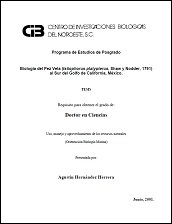Producción de pigmentos procedentes de Arthrospira maxima cultivada en fotobiorreactores
Production of pigments from Arthrospira maxima cultivated in photobioreactors
Author
Lolymar de los Ángeles Romero Maza
Miguel Guevara
Bertha Olivia Arredondo Vega
Metadata
Show full item recordAbstract
"El cultivo de cianobacterias, como Arthrospira, puede realizarse en sistemas abiertos y sistemas cerrados o fotobiorreactores. El objetivo de la presente investigación fue evaluar la producción de pigmentos de Arthrospira maxima cultivada en dos tipos de fotobiorreactores. El cultivo se realizó de forma discontinua (Batch) bajo ambiente controlado, en fotobiorreactores helicoidales y cilíndricos, durante 30 días, en medio Zarrouk. La determinación de los pigmentos se realizó en las fases de crecimiento exponen-cial y estacionario. Para los pigmentos liposolubles, la biomasa se sometió a extracción con acetona 90%, y posterior determina-ción por Cromatografía Líquida de Alta Eficiencia, y para la extracción de los pigmentos ficobiliproteínicos se ensayaron cuatro métodos: 1. regulador de fosfatos/enzimas; 2. solución alcalina, previo tratamiento con CaCl2; 3. buffer de fosfato, previo trata-miento con hielo seco y 4. agua (4ºC), y posterior determinación por Espectrofotometría UV-Visible. Los mayores valores de pig-mentos liposolubles fueron obtenidos en los cultivos realizados en fotobiorreactor helicoidal durante la fase exponencial (clorofila a 11,08±0,006 μg mL-1; β-caroteno 1,82±0,003 μg mL-1; zeaxantina 0,72±0,002 μg mL-1); mientras que los mayores contenidos de los pigmentos ficobiliproteínicos se obtuvieron en fotobiorreactor cilíndrico, durante la fase estacionaria, utilizando el buffer de fosfato tratado con hielo seco para la extracción. Dentro de las ficobiliproteínas, fue la ficocianina la que se encontró en mayor proporción (FC = 77,74±0,767 mg L-1), seguido por la aloficocianina y ficoeritrina. Se concluye que la biomasa de Arthrospira maxima presenta potencial biotecnológico por sus altos contenidos de pigmentos." "The culture of the cyanobacteria Arthrospira maxima can be done in open systems and closed systems or photobioreactors. The objective of the present research was to evaluate the pigment production of Arthrospira maxima grown on two types of photobio-reactors. Batch system culture with Zarrouk´s medium was carried out under controlled conditions in a helicoidal and cylindrical photobioreactors during 30 days. Pigments determination was carried out in exponential and stationary growth phases. Biomass was extracted with 90% acetone, and the liposoluble pigments were injected in a HPLC. For the phycobiliprotein pigments extrac-tions, four methods were tested: 1.- phosphate regulator/enzyme, 2.- alkaline solution, after treatment with CaCl2; 3.- phosphate buffer, previous treatment with dry ice, and 4.- water (4 °C), and subsequent determination by UV-Visible Spectrophotometry. The highest pigments content was obtained in the helicoidal photobioreactor cultures during the exponential phase (chlorophyll a 11.08±0.006 μg mL-1, β-carotene 1.82±0.003 μg mL-1, zeaxanthin 0.72±0.002 μg mL-1). Moreover, the highest contents of phyco-bilipretein pigments were obtained in a cylindrical photobioreactor, during the stationary phase, with phosphate buffer with dry ice extraction. Among the phycobiliproteins, the phycocyanin was in highest content (77.74±0.767 mg L-1), followed by allophyco-cyanin and phycoerythrin. It is concluded that the biomass of Arthrospira maxima presents biotechnological potential due to its high pigment contents."
Collections
Related items
Showing items related by title, author, creator and subject.
-
PROMOCIÓN DEL PERIFITON PARA EL CULTIVO DE CAMARÓN BLANCO: HACIA UNA ACUICULTURA ECOLÓGICA
DOMENICO VOLTOLINA LOBINA; JUAN MANUEL AUDELO NARANJO; MARIA DEL ROSARIO PACHECO MARGES -
Suelo y Erosión
YOLANDA LOURDES MAYA DELGADO


